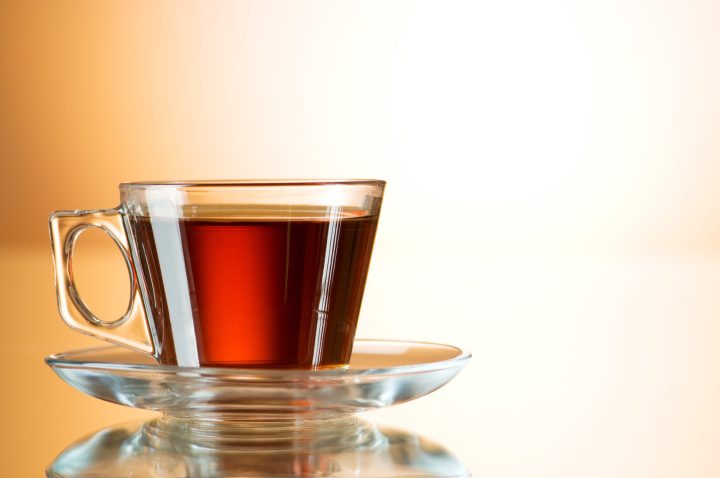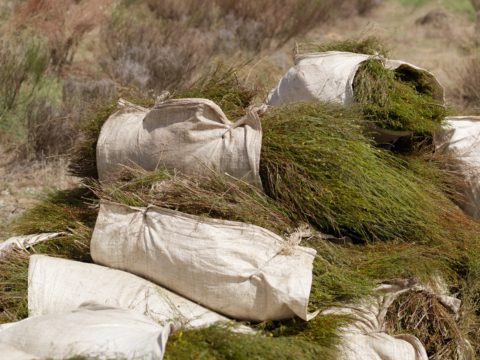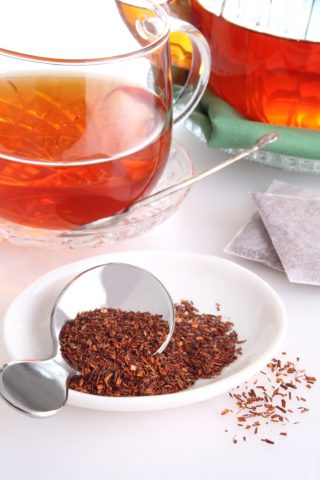RED RED TEA
Rooibos tea is a balm, inside the body and out

Like Champagne, the European Commission has approved the registration of the designation ‘Rooibos’/’Red Bush’ in its register of protected designations of origin and protected geographical indications – the first African food to be recognised in this way.
The writer supports the Journey’s End Foundation, established in August 2020 to tackle hunger in the Helderberg Region of Stellenbosch.
Rooibos is rather amazing. The plants grow only in a very small region of the Western Cape, around Clanwilliam, in roughly a 100 km radius. How this tiny semi-arid part of the world – with extreme temperatures from 50°Celsius in summer and below freezing in winter – can sustain the entire industry is a miracle in itself.
“Part of the fynbos family, rooibos is unique and grows nowhere else in the world,” says Adele du Toit, spokesperson for the SA Rooibos Council (SARC). Given this, careful attention must be paid to farming practices so international standards applicable to the rooibos industry include EU organic certification, sustainability certification, and social certification, including but not limited to The Rainforest Alliance and UTZ, The Sustainable Agriculture Network and Fairtrade International.
A fancy new feather in the cap is the June 2021 registration by the European Commission of the designation “Rooibos/Red Bush” in its register of protected designations of origin and protected geographical indications where it joins Champagne, Irish Whiskey, Porto, Queso Manchego and other products.
What this means is consumers will be able to know what they are buying is the real deal: “The registration means Rooibos or Red Bush can only be used to refer to the dried leaves of 100% pure Rooibos/Red Bush derived from Aspalathus linearis that has been cultivated or wild-harvested in designated local municipalities of the Western and Northern Cape. Rooibos/Red Bush may be blended with teas, infusions or other products, whether or not for human consumption,” are the official words.

Rooibos grows only within a 100km radius of Clanwilliam in the Western Cape. (Photo: Supplied)
Rooibos is the first African food to receive the status of a protected designation of origin in the EU register, and the registration will go a long way towards sustaining the rooibos industry, said Du Toit. “Higher consumption of rooibos due to increased recognition will contribute to the preservation of traditional knowledge and further uplift small-scale farmers in the indigenous communities producing rooibos.”
Although we drink it in similar ways – brewed in a cup with perhaps the addition of milk, sugar, lemon or honey – rooibos is a fermented herbal tea; black and green tea is tea made from the Camellia Sinensis plant, but is produced using different methods.
“Herbal teas are made from any other plant, and can include leaves, roots, fruits and even flowers. Rooibos is considered to be a herbal tea. Rooibos is mostly known in its fermented form, which gives the tea its rich amber colour. When the plant is harvested (green leaves) and processed, it is mixed with water and left to ferment in the hot African sun,” said Du Toit. “The fermentation process changes the colour to the deep red we know and love. Green rooibos is different – the fermentation process is omitted, so the tea is dried immediately after harvest, and the tea has a much lighter colour when brewed.”

After it’s picked, rooibos is left in the sun to ferment, which gives the tea its rich amber colour. (Photo: Supplied)
Tea consultant and specialist Jessica Bonin, who began her business in a caravan in De Waal Park, Cape Town, later moving to premises in Woodstock, then Long Street, expanded. “Tea historically refers specifically to the Camellia family of plants native to East and South East Asia. How Camellia is grown and processed determines whether it is a black or green tea based on differing levels of oxygen present in the leaves.
“Plants we drink in the same way as tea – leaves steeped in hot water – that are not from the Camellia family are classified as herbal. Mint, for example, are leaves from the Mentha plant and not the Camellia plant, therefore mint is herbal. English Breakfast or Ceylon is from the Camellia plant and fully oxidised, making it a black tea.”
In my previous encounters with Bonin (who introduced me to the pleasures of matcha, and tranquil tea ceremonies), she advocated the use of loose tea over bags, and I have to admit it’s a lovely gentle – and genteel – ritual of brewing a warm beverage. But I’m also lazy, and do that horrific thing of pouring the water over a bag, dunking it a few times, and drinking. With rooibos though, I’m a bit more restrained; I don’t let the kettle boil until it switches off, and I let the mug stand with the bag until it’s strong, and cool enough to drink. Oftentimes I forget about it entirely, which is mildly annoying. “Oh my tea, gosh darnit!” is something I yell quite a bit, or words to that effect.

Loose leaves or bags? In the case of rooibos, bags are good. (Photo: Supplied)
“Loose leaf over tea bags is the preference for the Camellia tea leaf and is not necessarily applicable to herbal varieties,” said Bonin. “‘Loose leaf’ really refers to ‘full leaf’. In order to fit all the leaves into a tea bag, they have to be cut into what we call ‘fannings’.
“The Camellia leaf contains over 2,000 different ‘chemicals’ that express themselves in flavour and smell. When the tea leaf is broken, it is prevented from imparting its full flavour potential. Rooibos, however, has leaves that resemble pine needles and small stalks are often included in the cut used for drinking. As a result, rooibos handles well in a bag despite smaller leaf sizes being used.”
Which makes me feel far less guilty, thank you Jessica. My other concern was that nowadays I don’t get that big, deep, earthy hit in my first sip, the one that makes rooibos so different from other teas. I wanted to know why.
“It depends entirely on the brand,” said Bonin. “A good quality rooibos should be woody, sweet, rich and creamy with a steep of three to five minutes. Aim for a tea bag that has at least 2 to 2.5g and test the various brands to find one that has your preferred flavour profile and strength.”
On it.

Studies have shown rooibos can reduce ‘bad’ cholesterol. (Photo: Supplied)
But not all rooibos is created equal. There are blends and infusions and added flavours; I like using them to make sweet cold tea which I keep in the fridge to dilute with soda water for a refreshing summer beverage, with lots of ice and garnish in a goblet.
“I love rooibos blends!,” said Bonin. “The best blends for my personal preference are ones that use natural ingredients. Rooibos is so incredibly versatile, and its flavour profiles acts as the perfect foundation to add an almost infinite array of blends from florals to herbals and even spices.
“The infusion that works best at different times depends on the ingredients used. Mint is excellent for digestion, therefore a rooibos and mint after meals is a good time. Chamomile is great to reduce stress and induce sleep; having rooibos and chamomile at night will ensure a good night’s sleep. Masala spices are very soothing and wonderful when mixed with rooibos as a base. I love rooibos chai in the afternoons around teatime mixed with milk and honey. Rosehip is full of antioxidants, adding a power punch to the ones rooibos already has. I would drink this in the mid-morning as it’s refreshing and energising. Morning is a great time to drink rooibos with lemon and ginger to get the digestion started and the mind clear for the day ahead.”
Rooibos has been familiar to us as a drink for generations, but there’s much more to it, and many ways to reap its benefits. “The industry is doing well, and we are seeing many different product innovations coming to the forefront other than traditional tea. Rooibos is increasingly being used in foods, alcoholic beverages like liqueurs and gin, beauty products and health supplements,” said Du Toit.
“Global awareness of the tea is also on the increase. This is because people love the story about rooibos – its uniqueness and exclusive area it grows in – and it comes from Africa, deemed to be exotic and fascinating in other parts of the world. The biggest export markets are Japan, Germany and the Netherlands that collectively make up about two thirds of total exports. On average about 14,000 tonnes are produced yearly; half of all rooibos is consumed locally, while the rest is exported.”
In 2018, rooibos made a brief appearance in an issue of Marvel Comics’ She-Hulk when psychiatrist Flo Mayer offered Jennifer Walters (also known as She-Hulk) a cup of tea to calm her down. Rooibos was among the options. Research done by several academic institutions, including Stellenbosch University, have shown Rooibos tea’s ability to alleviate stress and anxiety levels.
Among the many other health benefits are antioxidants to improve the skin, and it has been proven to decrease the body’s production of cortisol – the nasty stress hormones which can increase one’s appetite for comfort food which can lead to weight-gain. I drink several cups of rooibos daily, in its purest form without milk, sugar or any other additions, so by rights I should be calm, skinny and have far fewer wrinkles. Then again, what might I look like if I don’t drink the tea?
What I can vouch for is how a rooibos bath or rinse can soothe inflamed itchy skin (like eczema or other skin conditions). When I got chickenpox in my adult years (utterly gross), my ex mother-in-law told me to pour cool rooibos tea over myself to help the itchiness and also to dry up the pustules (even grosser). It works, and I pass this bit of old fashioned home remedy on whenever I can.

Rooibos tea, prepared, and leaves. (Photo: Supplied)
Besides these outward benefits, rooibos is good for our insides too. Professor Jeanine Marnewick (PhD, MRSSAf, Research Chair: Biotechnology, Director: Applied Microbial and Health Biotechnology Institute, Cape Peninsula University of Technology) has reams of facts at her fingertips, and you can read more on the SARC website.
“Rooibos contains no caffeine, and has very low levels of tannins when compared to the traditional Ceylon teas, and a plethora of unique and other antioxidant compounds,” said Marnewick. “Already these characteristics make rooibos attractive to those who may be caffeine-sensitive or struggle with their blood iron levels (tannins are known to bind dietary iron when consumed with food, and rooibos contains very few tannins).
“The focus of our research and that of others across the world the past decade has been on rooibos and heart health. Heart disease is a very complex disease with a number of contributing factors involved, but we know from past studies that there exists a link between an increased consumption of phytochemicals (compounds derived from plants) and the prevention of certain lifestyle diseases (such as atherosclerosis, heart disease, type 2 diabetes).
“A study by researchers from Sweden reported rooibos to suppress the enzyme involved in the development of high blood pressure. This they measured 30-60 minutes after healthy volunteers consumed 400 millilitres of rooibos. Then in our own study we showed rooibos to improve the cholesterol profile of participants who all had two or more risk factors for developing heart disease. Consuming six cups of rooibos throughout the day for a period of six weeks resulted in a significant reduction in the level of LDL (‘bad cholesterol’), triglycerides and a significantly improved level of HDL (‘good cholesterol’).
“Through these and other studies I think it is clear that we should make rooibos part of our daily health regime to assist our bodies.”
Du Toit confessed she is a bit obsessed (which is why she has the job): “I just love knowing that I am using a product that is made locally and supports our local economy. I also use rooibos in supplement form and drink probably around 8 to 10 cups a day. I have recently become sensitive to caffeine, and rooibos is a fantastic alternative to coffee and normal tea as it is caffeine-free.”
For more information, click here.
Rooibos chicken bake
Serves 6 – 8
Ingredients
1 kg chicken pieces
Salt and pepper to taste
2 onions, quartered
10 cloves garlic, peeled but kept whole
1 sachet (250 g) prunes
15 ml grated lemon rind
375 ml rooibos tea
125 ml rosé wine
60 ml olive oil
2 bay leaves
6 sprigs thyme
1 sachet (200 g) green olives, pitted
10 capers
Fresh coriander leaves
Method
Preheat the oven to 160°C.
Arrange the chicken pieces in an ovenproof dish, season with salt and pepper. Add the onions, garlic and prunes. Sprinkle with lemon rind.
Mix the rooibos tea, wine, olive oil and herbs and pour over. Marinate for at least an hour.
Bake for one hour, then add the olives and capers and bake for another half an hour until the meat is done and tender.
Arrange in a serving dish and garnish with a bunch of fresh coriander leaves. Serve with mashed potato or polenta with feta cheese mixed in.
Choc-rooibos cupcakes
Makes about 24
Ingredients
Cake:
750 ml cake flour
350 – 500 ml sugar
90 ml cacao
10 ml bicarbonate of soda, sifted
160 ml oil
10 ml vanilla essence
30 ml brown vinegar
500 ml strong rooibos tea, cooled
Icing:
1 sachet (200 g) dark chocolate disks
About 125 ml Greek yoghurt
Food dust and cake decorations of your choice
Method
Preheat the oven to 180°C.
Place paper cups in the hollows of two muffin pans (12 hollows each).
Cake:
Sift together all the dry ingredients. In another bowl beat together the oil, vinegar vanilla essence and tea.
Add to the dry ingredients and beat well with a wire whisk.
Spoon spoonfuls of the batter into each paper cup until ¾ full. Bake for about 30 minutes until done and a testing skewer comes out clean when inserted into the centre of each cup cake.
Ganache icing:
Melt the chocolate in the microwave oven at 100% power or in a glass bowl over boiling water until melted. Stir in the yoghurt and stir well. Spoon onto each cup cake and decorate. Leave to cool.
Rooibos tea and berry crème brûlée
Makes four servings
Ingredients
250 ml cream
30 ml desiccated coconut
3 rooibos tea teabags
250 ml coconut cream
6 large egg yolks
80 ml xylitol granules and extra for brûléeing
125 ml mixed berries
45 ml almonds, toasted and chopped (optional)
Mint, to garnish
Tips: You don’t need to add a layer of xylitol on top as the baked custard is delicious on its own as well. It is then very similar to pots de crème. Do not blowtorch the custards for too long as the heat will melt the dessert too much and result in a watery liquid seeping out from it.
Method
Preheat the oven to 160°C.
Heat the cream, coconut and rooibos tea teabags in a saucepan. Remove it from the heat just before it starts to boil. Leave it to steep for 30 minutes. Strain it through a fine sieve.
Place four ramekins in a deep oven dish that can act as a water bath.
Whisk the coconut cream, egg yolks and xylitol together. Add in the strained tea mixture and whisk until smooth. Divide the berries between the 4 ramekins and pour the mixture on top. Once the ramekins are in the baking dish, fill it up with enough water to come halfway up the sides of each ramekin.
Bake for 30-35 minutes or until the custard is set but still a bit wobbly. Allow it to cool and then place it in the fridge for at least two hours until cold.
Sprinkle a thin layer of xylitol over each dessert and use a blowtorch to melt the sugar. It won’t caramelise much, but the sugar will melt. Once the sugar hardens it is ready to serve. If you prefer, scatter some chopped nuts on top to add a bit more texture. Garnish with mint.

Packed with all the good stuff, a green rooibos smoothie can kickstart your day. (Photo: Supplied)
Green rooibos smoothie
Ingredients
For 1 serving
1 small apple, cored
5 cm piece cucumber
1 stalk celery, including leaves
60 ml cup flat-leaf parsley, including stems
250 ml baby greens (your choice of spinach, chard, kale)
⅛ slice of lemon (including rind)
10 ml lemon juice
1 kiwi peeled
60 ml cup raw almonds
15 ml chia or sunflower seeds (optional)
250 ml brewed green rooibos tea, chilled
6-8 ice cubes
Method
Combine all ingredients except ice cubes in a high-powered blender.
Blend on high until smooth.
Add ice cubes one at a time until fully crushed and mixed.
Serve immediately.
Rooibos punch
Ingredients
500ml strong rooibos tea, cooled
500ml peach juice
At least 100ml vodka
1 lemon, thinly sliced
Handful fresh mint leaves
2 peaches, thinly sliced
Method
Combine all the ingredients in a large jug and stir well
Serve over ice

Rooibos tea cocktails. (Photo: Supplied)
Iced rooibos tea cocktail
Ingredients
60 ml rooibos espresso tea
30 ml cherry vodka
15 ml milk
125 ml of ice
Garnish: cherries
Method
In a serving glass add rooibos espresso, cherry vodka, and ice.
Stir mixture then add milk.
Garnish with cherries.
For the body: Face mask
Ingredients
15 ml mashed avocado
15 ml plain full-fat yoghurt
15 ml honey
50 ml strong rooibos tea (cooled down)
Tip: you can add a teaspoon of lemon juice which will stop the avo from oxidising and turning brown.
Method
Mix all the ingredients together and apply to the skin. Leave on for 15 minutes before rinsing with lukewarm rooibos water. DM/TGIFood















 Become an Insider
Become an Insider
“I drink several cups of rooibos daily, in its purest form without milk, sugar or any other additions, so by rights I should be calm, skinny and have far fewer wrinkles.” Ha Ha. Love the dashes of humour. Also, so interesting to read. Am going to see what happens if I up my rooibos consumption…
Wonderful article. And great news of the registration / designation. Thanks Bianca.